ASTANA – National games are deeply ingrained in the culture and history of Kazakhstan and are an essential part of the country’s national identity. They are still widely practiced in the country today.

Togyzkumalak. Photo credit: soyle.kz
Below is the list of the top five most popular national sports in Kazakhstan, according to the Ministry of Culture and Sports.
Togyzkumalak
Togyzkumalak (nine pellets) is a board game designed to develop logical and mathematical thinking and endurance. The game is based on the number nine, considered sacred by the ancient Mongols and Turks. The game is built not only on the speed of counting but also on tactics. The game can last four or five hours. Opponents have to use all four basic mathematical operations.
This game is available to everyone, regardless of age.
Kazaksha Kures
Kazaksha kures (Kazakh wrestling) is a traditional wrestling sport in Kazakhstan. It is one of the most ancient Kazakh sports, which remains popular to this day. Every festival or holiday celebration in cities and villages includes demonstrative competitions in Kazakh wrestling. This sport is similar to freestyle wrestling, but has different rules and techniques. The goal is to get your opponent on back.

Kazaksha Kures. Photo credit: inform.kz.
The sport utilizes a combination of physical strength and speed of action with resourcefulness and skill. The fight is immediately stopped after one of the opponents puts the other on the mat, as wrestling is only allowed while standing.
At the dawn of its development, Kazakh wrestling disregarded any weight and age restrictions. They were introduced after the establishment of the association of the sport and the start of official competitions.
In 2016, the United Nations Educational, Scientific and Cultural Organization (UNESCO) included Kazakh wrestling in the Intangible Cultural Heritage List.
Kokpar
Kokpar (riders compete for a goat carcass) is a national equestrian game of Central Asian countries. The game’s name originates from the words “kok bori,” which means gray wolf. Wolves were the worst enemies of nomads as they caused significant damage to livestock, so killing the wolf was considered a big achievement. The head of the dead wolf was offered to the head of the community, and the carcass was given to the crowd.

Kokpar. Photo credit: advantour.com.
Over time it turned into a game where the riders competed for a goat carcass instead of a wolf. Initially, the competition for the goat carcass was not just a game. It was used as preparation and training for future warriors. Riders and horses practiced together as the weight of the carcass could reach 50-70 kilograms, and the pace of the game was rigorous. Young people developed skills such as fighting on horseback and riding horses in extreme conditions on the battlefield. The team that gets hold of the carcass and throws it in the goal of the opposing team is the winner.
Asyk atu
Asyk atu is a board game with bones of a knee sheep joint. Asyk means a bone of a previously boiled knee joint of a sheep or ram. The game’s objective is to knock out one or more of the same bones lined up with your asyk from a certain distance. Asyks knocked out of a row become the property of the player who knocked them off. The game develops accuracy, resourcefulness and dexterity. It is a game for both adults and children.

Asyk atu. Photo credit: comode.kz.
Baige
Baige is a horse race over rough terrain over a distance of 5-15 kilometers where the tactical skill of the rider is imperative. Its origin is associated with the nomadic life and the need to prepare horses for traveling throughout the vast steppe. Currently, races are held at hippodromes.

Baige. Photo credit: gov.kz.
There are two types of baige: kunan baige (races of two-year-old foals) and alaman baige (races on adult horses from three years and older).
Alaman baige is a long-distance race over rough terrain. It is designed solely for the endurance of the horse. There is no definite standard for the length of the race.
National games are not just physical activities but cultural artifacts passed down from generation to generation. These games have deep roots in a country’s traditions, customs, and values and reflect people’s way of life. They help to maintain and promote cultural heritage.

